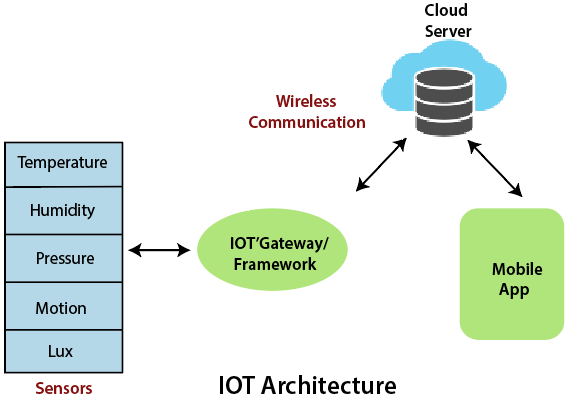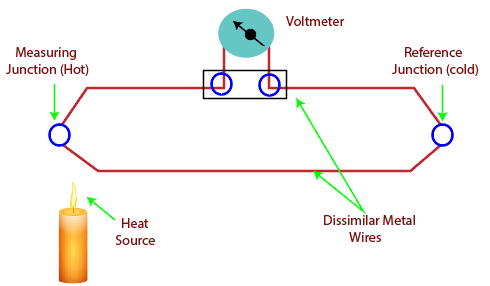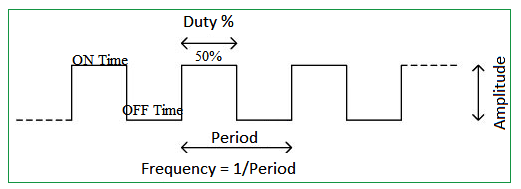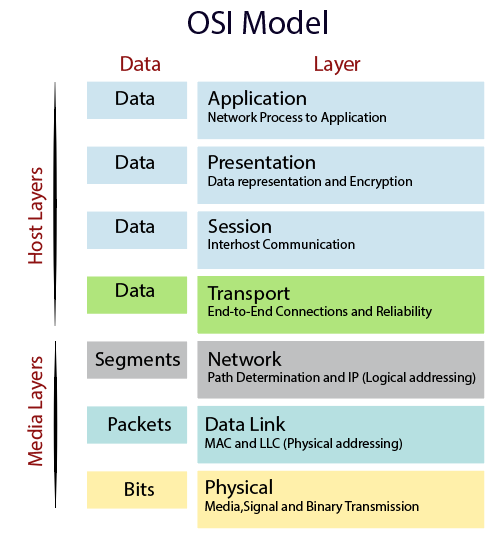Top 40 IoT Interview Questions and Answers in 2021
Q.1 What is IoT?
IoT stands for the Internet of things refers to the interconnection of the network of various devices that can recognize, collect and transfer data over the internet without human involvement.
It is a group of objects which we use in day to day life linked to a network. The objects embedded with the micro-controller, software, and sensors that enables these objects to recognize, collect and communicate with one another and users, playing a vital role on the Internet.

The IoT Model makes the web more insistent by easy access and communication with various devices. For example, surveillance cameras, home appliances sensors and many more. The Internet of things executed for the advancement of application that uses the data generated by the objects to provide services.
Q.2. What are the major components of the Internet of things?
These are the following major components of IoT:
- Smart devices or sensors:
Smart devices or sensors help in data collection from the surrounding. Collected data can vary from simple to complex.
The device can have multiple sensors joined together to do various things to sense things. For example, the mobile phone performs various tasks at a time.
- Connectivity:
Afterwards, the collected data is redirected to a cloud structure, but it requires a transmission medium for transportation. Sensors are linked to the cloud through the different transmission mediums of communication — for example, WiFi, Bluetooth, wide-area networks, Cellular network and many more.
There are many options, and every choice has some features, so, choosing the best connectivity option in IoT is essential.
- Data Processing:
When the Information is collected, and it gets to the cloud afterwards where processing of the collected data is taken place by the software. It can range from something simple to complex . For example, reading on devices such as checking the temperature on heater, Ac within the acceptable range. Sometimes it might be a situation where user interaction is required.
- User Interface:
After now, the information made available to the users in various ways like emails, notification through texts. Users also have an option to connect through the devices which they can check in their IoT system. For example, a user installed a camera in his office, he has an option to check the video recordings, and all other feeds through a web server.
Q.3. What are the Pros and cons of the Internet of things?
Pros:
- Automation and control:
The Internet of things permits you to automate and control the tasks which are performed in day to day life.
- Better efficiency:
Machine to Machine communication provides better results with more transparency. Moreover, people can free to do other jobs.
Cons:
- Privacy and security:
Managing privacy settings on the Internet is essential. Many of our day to day life machines,appliances and services become connected to the Internet with certain information available on the Internet which makes it harder to keep confidential information from the data breacher and spammers.
- Complexity:
Internet of things is such an extensive, distinct network, A single error in software or hardware may cause significant consequences.
Q.4. Name some of the various sectors where IOT played a major role?
IoT is covering almost all sectors. Some important major sectors are as follows:
- Manufacturing
- logistics(GPS tracking)
- Real Estate and Housing(smart homes)
- Health care(TeleMedicine)
- Agriculture
Q.5. What is the scope of the Internet of Things devices in the future?
- With the exponential growth in the last few years, we can say that the future of IoT or the scope of IoT is something increasing massively in an unusual way. As per NASSCOM Report, the global market size of IoT is expected to touch USD 3 trillion by 2020.
- In the 19th century, only a few people were aware of the Internet globally. Internet of Things came into existence at that time.
- As per the report, in the year 2017, there were only 8.4 Billion IoT connected devices worldwide. With time it increased to 9.2 Billion by 2018.
- As per the survey report, the usage of IoT application based devices will increase tremendously. It will impact people a day to day lives. Convenience and its features will attract people towards the tech device.
Q.6. What are the challenges in IoT?
Security and power utilization are major concerned in IoT. Various devices connected through a single network source. An only problem may affect all the tools which lead to significant consequences.
Q.7. Which are the most used sensors types in IoT?
For a long time, organization and Industries have been using various types of sensors. After the invention of IoT, it has taken the expansion of sensors to an advanced and different level. These are the following most used sensors in IoT; Temperature sensor, proximity sensor pressure sensor,water quality sensor, chemical sensor,Gas sensor, and so on.
Q.8. How would you detect fire, which sensor is suitable?
The smoke sensor is a device that detects smoke, and it is an indicator of fire. If something caught by fire, then the security device transmits a signal to a fire alarm control panel.
Smoke sensors shaped like a disk having the physical dimension is about 150 millimetres in diameter and 25 millimetres thick, shape and size may vary.
Q.9. What is Thermocouple, and How does it work?
A Thermocouple is an electrical device comprised of two different electrical conductors joined together to forman electrical junction at different temperatures. This junction is used to measure the temperature. When the junction experiences a temperature change as a result of the Thermoelectric effect, Thermocouple produces a temperature-dependent voltage, and this voltage is interpreted using Thermocouple across the junction to measure the temperature.

The thermocouple working principle based on three effects, discovered by Seebeck, Peltier, and Thomson.
- Seeback Effect: The Seeback Effect states that when two different or unlike electrical conductors are joined together at a junction then an Emf is induced and the value of induced Emf is different for each electrical conductor.
- Peltier Effect: Peltier Effect states that when two dissimilar conductors are joined together at a junction. An Emf induced in the circuit due to the temperature difference of the two electrical conductors.
- Thomson Effect: Thomson Effect states that when two dissimilar or unlike electrical conductors are joined together at a junction. The potential induces within the circuit due to the temperature gradient across the entire length of the electrical conductors.
Q.10. What is Arduino?
Arduino is an open-source electronics platform consists of hardware and software with easy to handle characteristics. Arduino boards are mainly a microcontroller that receives input from sensors to control a motor and so on automatically.
Q.11. What are GPIO pins?
GPIO stands for “General purpose input/output”. GPIO pins generally found on the integrated circuit that doesn’t have a particular function. The primary purpose of the GPIO pins are redirecting a signal to a specific component, various features of the GPIO pins are configurable and can be regulated by the software.
Q.12. What is the latest Raspberry Pi release?
Raspberry Pi, 4 Model B, was introduced in June 2019 by the RPi team with some advanced features that have a 1.5 GHz 64-bit ARM Cortex-A72 processor.
Q.13. How many GPIO pins are there in the latest Raspberry Pi?
Raspberry Pi, 4 Model B, has 40 GPIO pins that can recognize as well as write digital data.
Q.14. List a few operating systems which support Raspberry Pi?
These are the following operating systems that Raspberry pi supports:
- Raspbian
- OSMC (Open Source Media Centre)
- Open ELEC (Open Embedded Linux Entertainment centre)
- RISC OS
- Windows IoT Core
- Lakka
Q.15. What are the wireless communications boards present in Raspberry Pi?
Raspberry pi supports Wifi and Bluetooth/BLE for wireless communication.
Q.16. What Python libraries used in Raspberry Pi to control GPIO pins?
RPi.GPIO 0.5.4 is the latest python libraries used in Raspberry Pi to control GPIO pins.
Q.17. What is PWM?
PWM (Pulse Width Modulation) or PDM (Pulse Duration Modulation) is a method for generating an analog signal via the digital source. PWM mainly consists of two different components that describe its operation and a frequency.
Duty cycle defined as the number of times the signal is in ON state as what percentage of the total time it takes to complete one revolution.

Frequency is defined as how much time taken by the PWM to complete one revolution.
- Frequency= 1/Time period
- Time Period= Time On+ Time Off
Q.18. List some applications of PWM in IoT?
Pulse Width Modulation has various applications in IoT:
- Dimming LED
- Speed control DC motor
- Direction control of Servo Motor
Q.19. What sensor and actuator are used to control home appliances from any IoT devices in wired mode?
The sensor and actuator are used to control any home appliances by using an electrically operated switch called Relay. The primary purpose of the utilization of Relay in Electrical Circuits is to protect the electrical circuit, electrical appliances, etc. if any breakdown or short circuit occurs.
Q.20.What is BLE in the Internet of Things?
BLE (Bluetooth Low Energy) is a type of wireless communication specially designed for short-range transmission. It uses 2.4 GHz frequency that allows various devices to communicate with each other. For example, WiFi which utilizes low power.
Q.21. What are the examples of the MEMS sensor?
MEMS stands for “Microelectromechanical System” is a teeny machine having both the mechanical and electrical components.The physical dimension of the component lies between 1 to 100 micrometres. Examples:
- ADXL345
- Accelerometer
- piezoelectric sensor
- MPU6050- Gyroscope.
Q.22. What is the IoT Cloud?
IoT cloud is an effective platform to store and collect Internet of Things data, designed by Salesforce.com. It collects data from various sources like devices, websites, applications, customers to prompt actions for the time responses.
Q.23. What is the OSI Model in IoT?
An OSI(Open Systems Interconnection) is a reference model developed by ISO(International Organization for Standardization).
It defines how the system transfers the data via a physical medium to communicate with another system.
OSI Model divided into seven segments or seven-layer where each Layer is responsible for performing particular tasks and transferring the completed tasks to the next Layer for further processing.

Seven layers of the OSI Model are:
- Layer 7: Application Layer
- Layer 6: Presentation Layer
- Layer 5: Session Layer
- Layer 4: Transport Layer
- Layer 3: Network Layer
- Layer 2: Data-Link Layer
- Layer 1: Physical Layer
Q. 24. What is the ZigBee protocol?
ZigBee protocol provides cost-efficient, energy-efficient supporting wireless technology based on the IEEE 802.15.4 standards which is generally used for two ways communication between sensors and control systems. It is very similar to wifi or Bluetooth because its low range varies between 10 meters to 100 meters.
Q.25. What are the sensors used in Agriculture?
In the current trend, people are following the modern approach for better Agriculture management aim to achieve the maximum utilization of the tools(Sensors) for better agriculture requirements.
These are the following sensors and its use in Agriculture sector:
- Electromagnetic Sensors: Electromagnetic sensors used for measuring soil moisture content, salt content, organic matter, and texture.
- Airflow sensors: Airflow sensors used for measuring the Soil Air porosity.
- Acoustic Sensor: Acoustic Sensors used for determining the soil texture.
- Electrochemical Sensor: The Electrochemical sensor measures soil nutrients level.
Q.26. What is meant by the library in Arduino in IoT?
The library contains several codes written for controlling the sensor or module.
Q.27. Meaning of Sketch in Arduino in IoT?
A sketch is the unit of code that is transferred to and keep running on an Arduino board where asketch is a name that Arduino uses for a program.
Q.28. What is the application of IoT in Environmental Monitoring?
IoT Application plays a vital role in Environmental Monitoring. It has broad application. Extreme weather monitoring, Environmental protection, endangered species protection, water safety, commercial farming, and many more. In these applications, various software or tools detect and measure every type of environmental change. For example, sensors.
- Air and water pollution:
In the current environmental monitoring system, primarily rely on manual labor with advanced instrument and various lab processes for Air and water pollution. IoT induced some advanced technology that reduces manual labor, allowing major sampling, allowing complicated onsite testing.
2. Commercial Farming:
In the current trend, many sophisticated commercial farms have denied advanced technology and biotechnology for some time, Iot Introduces better access to extensive analysis and automation.
Q.29. What is IoT ThingWorx?
ThingWorx is a platform for sustainable development and implementation of active connected devices. It is a combination of IoT enhancement tool which supports analysis, production, connectivity and other aspects of IoT Enhancement.
Q.30. Explain IoT GE Predix?
In IoT GE Predix, GE stands for “General Electronic”, In Other Words, we can say that IoT GE Predix. It is a Software Platform for the collection and examination of data; generated as sensors attached from the various Instruments(Electrical or Mechanical) used in the industries such as Healthcare, Aviation, Energy and transportation.
IoT GE Predix produces a cloud-based on PaaS (Platform as a service). It allows Industrial-scale analytics for Performance management and operational development which provides better and faster decision making and an excellent way to interconnect data, machine, and people. Every Layer of the platform has high-security protection. Many different services (Data Privacy, Authentication, User management, Authorization) help to minimize the risk associated with programs.
Q.31. How the Internet of Things Impact Our Daily Lives?
Internet of Things is the network of different types of devices that may be portable, wearable and implantable. The effect of advanced technology on the business or the development of the organization is prominent. With the significant enhancement in the latest technology, companies need to adopt the new technology which is in trend to go ahead in the future. It plays a role as a medium to communicate with devices and systems which are severe in real-time. We can say that IoT will have an impact on every stage of our lives because innovation is going to transform technology as well as our lives.
- IoT enabled parking:
Parking is a significant problem, primarily in urban areas. The traveller has to spend more time, energy, fuel to find a better parking place. During peak hours, the situation gets worse; the Internet of Things can overcome this problem. New startups have officially executed advanced technology to get rid of these problems in many areas. This startup gives an outlook on all authorized parking spaces in many areas. IoT reduces human effort and allows users to view availability and book a parking spot from their place and even make payment through an electronic wallet. The result is that this process is time-efficient as well as hassle-free.
- Internet of Things (IoT) Enabled Home Automation:
Home automation is a vast platform where tech-companies are focusing. It offers various advantages, For example, Imagine your room appliances like your Air conditioning is automatically adjusted the temperature (based on the weather conditions) without your involvement. It looks pretty tempting; this is only possible with the Internet of Things. Right now everyone can't afford this because it is quite expensive. This technology is only being used in the residences of wealthy people, but with time, the cost of this technology going to reduce, and this technology will be available for everyone.
Advantages of IoT in Home Automaton:
- It saves energy
- It reduces electricity bills
- It reduces human effort
Q.32. What is GainSpan’s GS2000 Protocol for the Internet of Things (IoT)?
The GS200 is an energy-efficient WLAN and WPAN framework on a chip. It consists of a media access controller (MAC), baseband processor, memory and a system control application processor and all these equipments bound on a single silicon die. It provides ultra-low-power consumption by keeping the devices on power saving mode when data transmission is on standby mode.
The GS2000 comes with embedded software stacks that offer a highly reliable, manageable and secure wireless network to meet the increasing demand of wireless network systems accepted by IEEE 802.11 standards.
Q.33. What is Big Data and How it is related to IoT?
Big data relates to a massive amount of data that can be unstructured, semi-structured and structured. It can extract data for information used in advanced analytics applications and machine learning projects.
Big data generally described by 3vs concept:
I. Volume:
II. Velocity:
Velocity refers to the speed with wich data generated. Consider an example of social media insights, 500 Million tweets are posted on Twitter every day, 9OO Million photos uploaded on Facebook daily. Big data helps the company to collect the data from the flow of data, and at the same time, frame processes the data so that it doesn’t slow down the process.
III. Variety
Variety in Big Date Includes Structured, Semi-structured and unstructured data that has the probability of getting generated either by machines or human. For example, ECG reading, Handwritten text, tweets, Emails, etc.
Variety in Big Data can also be defined as the ability to arrange incoming data from various categories.
Q.34. What is the role of publishers in IoT?
Publishers are the very lightweight sensors that deliver real-time information to the intermediate devices.
Q.35. What are the commonly used protocols in IoT?
Internet of things protocols can be divided into two basics type:
- IoT Network Protocols
- IoT Data Protocols
Primarily used IoT Protocols are as follows:
- Bluetooth
- WiFi
- ZigBee
- MQTT
- CoAP
- DDS
- NFS
- Cellular
Q.36. What is the abbreviation of MQTT?
The abbreviation of MQTT is “Message Queue Telemetry Transport.”
Q.37. What is IoTContiki?
Contiki is an operating system specifically designed for low power wireless Internet of Things devices having confined memory, bandwidth, and power. It utilizes a moderate design while still packing the essential tools of the present-day working framework.
Basic Applications of Contiki:
- Street lightning
- Sound monitoring
- Radiation monitoring
- Alarms
Q.38. List the Industries that are using IoT currently?
IoT Isn't constrained to specific industries; however, it varies from industries to industries. IoT was first started to begin in Manufacturing industries, for example, Car manufacturing where the majority of the mechanical operations were automated.
List of some Industries that are using IoT Currently are as follows:
- Consumer Electronics
- Healthcare
- Manufacturing
- Transportation
- Construction
Q.39. Explain a live case example of IoT?
The fitness band is a live case example of IoT devices in which the communications between mobile phones and the fitness band happen automatically.
Q.40. What is Bluegiga APX4 convention for the Internet of Things (IoT)?
The Bluegiga APx4 is a Power-efficient wireless system based on 450 MHz ARM9 processors that support BLE (Bluetooth Low Energy) and WiFi.